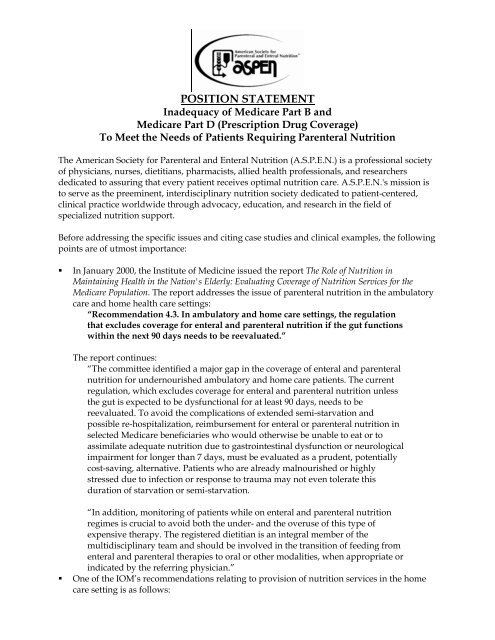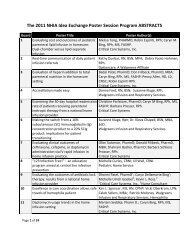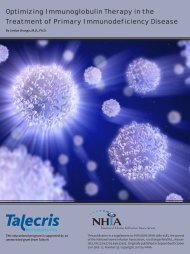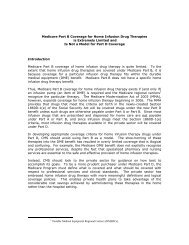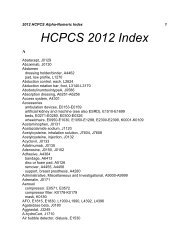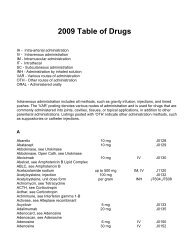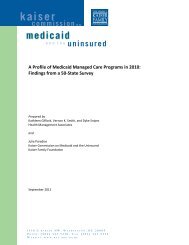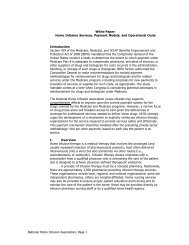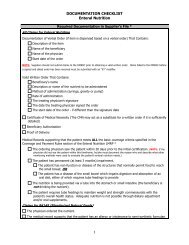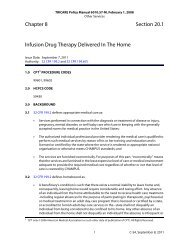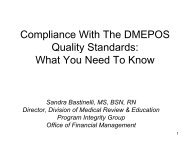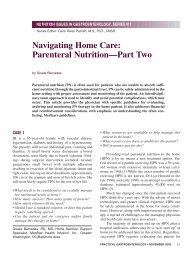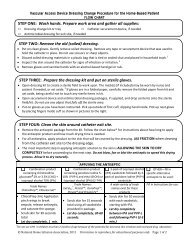Inadequacy of Coverage Under Medicare Part B and - NHIA
Inadequacy of Coverage Under Medicare Part B and - NHIA
Inadequacy of Coverage Under Medicare Part B and - NHIA
You also want an ePaper? Increase the reach of your titles
YUMPU automatically turns print PDFs into web optimized ePapers that Google loves.
POSITION STATEMENT<br />
<strong>Inadequacy</strong> <strong>of</strong> <strong>Medicare</strong> <strong>Part</strong> B <strong>and</strong><br />
<strong>Medicare</strong> <strong>Part</strong> D (Prescription Drug <strong>Coverage</strong>)<br />
To Meet the Needs <strong>of</strong> Patients Requiring Parenteral Nutrition<br />
The American Society for Parenteral <strong>and</strong> Enteral Nutrition (A.S.P.E.N.) is a pr<strong>of</strong>essional society<br />
<strong>of</strong> physicians, nurses, dietitians, pharmacists, allied health pr<strong>of</strong>essionals, <strong>and</strong> researchers<br />
dedicated to assuring that every patient receives optimal nutrition care. A.S.P.E.N.'s mission is<br />
to serve as the preeminent, interdisciplinary nutrition society dedicated to patient-centered,<br />
clinical practice worldwide through advocacy, education, <strong>and</strong> research in the field <strong>of</strong><br />
specialized nutrition support.<br />
Before addressing the specific issues <strong>and</strong> citing case studies <strong>and</strong> clinical examples, the following<br />
points are <strong>of</strong> utmost importance:<br />
• In January 2000, the Institute <strong>of</strong> Medicine issued the report The Role <strong>of</strong> Nutrition in<br />
Maintaining Health in the Nation's Elderly: Evaluating <strong>Coverage</strong> <strong>of</strong> Nutrition Services for the<br />
<strong>Medicare</strong> Population. The report addresses the issue <strong>of</strong> parenteral nutrition in the ambulatory<br />
care <strong>and</strong> home health care settings:<br />
“Recommendation 4.3. In ambulatory <strong>and</strong> home care settings, the regulation<br />
that excludes coverage for enteral <strong>and</strong> parenteral nutrition if the gut functions<br />
within the next 90 days needs to be reevaluated.”<br />
The report continues:<br />
“The committee identified a major gap in the coverage <strong>of</strong> enteral <strong>and</strong> parenteral<br />
nutrition for undernourished ambulatory <strong>and</strong> home care patients. The current<br />
regulation, which excludes coverage for enteral <strong>and</strong> parenteral nutrition unless<br />
the gut is expected to be dysfunctional for at least 90 days, needs to be<br />
reevaluated. To avoid the complications <strong>of</strong> extended semi-starvation <strong>and</strong><br />
possible re-hospitalization, reimbursement for enteral or parenteral nutrition in<br />
selected <strong>Medicare</strong> beneficiaries who would otherwise be unable to eat or to<br />
assimilate adequate nutrition due to gastrointestinal dysfunction or neurological<br />
impairment for longer than 7 days, must be evaluated as a prudent, potentially<br />
cost-saving, alternative. Patients who are already malnourished or highly<br />
stressed due to infection or response to trauma may not even tolerate this<br />
duration <strong>of</strong> starvation or semi-starvation.<br />
“In addition, monitoring <strong>of</strong> patients while on enteral <strong>and</strong> parenteral nutrition<br />
regimes is crucial to avoid both the under- <strong>and</strong> the overuse <strong>of</strong> this type <strong>of</strong><br />
expensive therapy. The registered dietitian is an integral member <strong>of</strong> the<br />
multidisciplinary team <strong>and</strong> should be involved in the transition <strong>of</strong> feeding from<br />
enteral <strong>and</strong> parenteral therapies to oral or other modalities, when appropriate or<br />
indicated by the referring physician.”<br />
• One <strong>of</strong> the IOM’s recommendations relating to provision <strong>of</strong> nutrition services in the home<br />
care setting is as follows:
A.S.P.E.N. POSITION PAPER/INADEQUACY OF COVERAGE UNDER MEDICARE PARTS B&D/2 OF 14<br />
“Recommendation 4.2. The availability <strong>of</strong> nutrition services should be improved<br />
in the home health care setting. Both types <strong>of</strong> nutrition services are needed in this<br />
setting: nutrition education <strong>and</strong> nutrition therapy. A registered dietitian should<br />
be available to serve as a consultant to health pr<strong>of</strong>essionals providing basic<br />
nutrition education <strong>and</strong> follow-up, as well as to provide nutrition therapy, when<br />
indicated, directly to <strong>Medicare</strong> beneficiaries being cared for in a home setting.”<br />
If parenteral nutrition is to be a benefit to <strong>Medicare</strong> beneficiaries who do not meet <strong>Medicare</strong><br />
<strong>Part</strong> B criteria, regardless <strong>of</strong> how the benefit is administered, it must be <strong>of</strong>fered as a<br />
comprehensive healthcare service, not as a “drug only” benefit. The ability to provide the<br />
appropriate level <strong>of</strong> pr<strong>of</strong>essional services along with the drug component <strong>of</strong> the therapy is<br />
essential to providing a safe <strong>and</strong> effective home care therapy.<br />
The IOM report continues:<br />
“<strong>Medicare</strong> beneficiaries are <strong>of</strong>ten discharged from hospitals to home care settings<br />
with, or at high risk for, overt malnutrition. Yet there is currently no HCFA<br />
regulation that requires a nutrition pr<strong>of</strong>essional to participate in the nutritional<br />
management <strong>of</strong> homebound patients. The adequate provision <strong>of</strong> services <strong>and</strong> the<br />
staffing <strong>of</strong> appropriately credentialed nutrition pr<strong>of</strong>essionals in home care are<br />
essential for the training <strong>and</strong> education <strong>of</strong> home health nurses <strong>and</strong> nurses aides<br />
so that they may adequately provide appropriate basic nutrition screening <strong>and</strong><br />
other services. In addition, nutrition pr<strong>of</strong>essionals should provide nutrition<br />
therapy directly to homebound patients when indicated.”<br />
Without coverage <strong>of</strong> the necessary pr<strong>of</strong>essional services under <strong>Medicare</strong> <strong>Part</strong> D, supervision <strong>of</strong><br />
home parenteral nutrition by competent credentialed nutrition pr<strong>of</strong>essionals will be impossible.<br />
Reimbursement for drugs alone cannot adequately solve this dilemma.<br />
• Clinical Monitoring for complex patients requiring artificial nutritional support (i.e.,<br />
parenteral <strong>and</strong> enteral nutrition at home) is not covered in either <strong>of</strong> the <strong>Medicare</strong> criteria.<br />
A.S.P.E.N. believes that monitoring these complex therapies is essential for good patient<br />
care. The A.S.P.E.N. home care st<strong>and</strong>ards state:<br />
"Patient monitoring shall be designed to determine the effectiveness <strong>and</strong><br />
appropriateness <strong>of</strong> nutrition support. The process <strong>of</strong> patient monitoring must<br />
insure that the nutritional goals are achieved. The monitoring process is also<br />
intended to reduce the risk <strong>of</strong> complications due to nutrition support. Each<br />
patient's nutrition status is monitored on a regular basis.<br />
• “The referring physician, home care organization, <strong>and</strong> nutrition support<br />
practitioner(s) should monitor the clinical status <strong>and</strong> response to nutrition<br />
therapy.<br />
• “Monitor the clinical status <strong>and</strong> compliance <strong>of</strong> the patient. This shall<br />
include but not be limited to: review <strong>of</strong> systems <strong>and</strong> physical<br />
examination; assessment <strong>of</strong> laboratory data; compliance with procedures<br />
to administer therapy.”<br />
• When patients transition from private insurance to the point at which <strong>Medicare</strong> becomes<br />
effective, they have to undergo a complete re-evaluation <strong>and</strong> apply for <strong>Medicare</strong> <strong>Part</strong> B<br />
coverage. If the patient is already receiving home parenteral nutrition, there are usually
A.S.P.E.N. POSITION PAPER/INADEQUACY OF COVERAGE UNDER MEDICARE PARTS B&D/3 OF 14<br />
difficulties in this transition resulting in patients not receiving coverage on time, or not<br />
getting coverage at all, as the patient must qualify based on the malady they already have<br />
that is being treated successfully. If the patient does not meet <strong>Medicare</strong> <strong>Part</strong> B criteria, at the<br />
present time the patient does not have a covered benefit for home parenteral nutrition even<br />
though they are already receiving this therapy. It is assumed, that such a patient would be<br />
entitled to parenteral nutrition under <strong>Medicare</strong> <strong>Part</strong> D under these circumstances.<br />
• While the guidelines as published appear straightforward, the interpretation <strong>of</strong> the<br />
guidelines is inconsistent from one regional provider <strong>of</strong> <strong>Medicare</strong> benefits to the next. This<br />
leads to delays in obtaining coverage after meeting the stringent criteria.<br />
In Appendix I, A.S.P.E.N. will provide, through case study <strong>and</strong> documentation the justification<br />
for an exp<strong>and</strong>ed medical necessity beyond the present <strong>Medicare</strong> <strong>Part</strong> B coverage; <strong>and</strong> the<br />
justification that <strong>Medicare</strong> <strong>Part</strong> D will also not meet the needs <strong>of</strong> patients requiring Parenteral<br />
Nutrition who must rely solely on the drug coverage provided under <strong>Medicare</strong> <strong>Part</strong> D.<br />
SUMMARY<br />
A.S.P.E.N. has reviewed coverage for patients requiring parenteral nutrition under <strong>Medicare</strong><br />
<strong>Part</strong>s B <strong>and</strong> D. A.S.P.E.N. believes that without exp<strong>and</strong>ing <strong>Medicare</strong> <strong>Part</strong> D coverage so that it<br />
encompasses all <strong>of</strong> the needs <strong>of</strong> the Parenteral Nutrition patient, the fragmentation in this<br />
benefit will create a population <strong>of</strong> needy <strong>Medicare</strong> beneficiaries that are under-served, or not<br />
able to be served at all. And, without revisions to the <strong>Medicare</strong> <strong>Part</strong> B benefit, those patients<br />
who do not meet the current medical necessity criteria under <strong>Part</strong> B, but who still have<br />
medically justifiable needs for parenteral nutrition will be under-served.<br />
On December 8, 2003, President George W. Bush signed into law the <strong>Medicare</strong> Prescription<br />
Drug, Improvement <strong>and</strong> Modernization Act <strong>of</strong> 2003 (Pub. L. 108-173), frequently referred to as<br />
MMA. This l<strong>and</strong>mark legislation for the first time provides seniors <strong>and</strong> individuals with<br />
disabilities with a prescription drug benefit under <strong>Medicare</strong>. Currently <strong>Medicare</strong> lacks an<br />
outpatient Prescription Drug Benefit. Drug coverage for present <strong>Medicare</strong> beneficiaries is<br />
limited to drugs that are incident to a physician's services or delivered in institutional settings.<br />
<strong>Medicare</strong> also covers certain drugs administered in the home care setting under the <strong>Medicare</strong><br />
<strong>Part</strong> B benefit. <strong>Under</strong> <strong>Medicare</strong> <strong>Part</strong> B, if an infusion pump is required the drug administered<br />
via the required infusion pump may also be covered. The pump must be either a portable or<br />
stationary pump operated either by electrical current or battery power. However, a medical<br />
necessity determination with extremely limited qualifying criteria is also in place for most <strong>of</strong><br />
these drug therapies. It is under <strong>Medicare</strong> <strong>Part</strong> B, within the coverage for Durable Medical<br />
Equipment, Prosthetics, Orthotics <strong>and</strong> Supplies (DMEPOS) that coverage is currently provided<br />
for parenteral <strong>and</strong> enteral nutrition (PEN). At present, any patient who receives parenteral or<br />
enteral nutrition under <strong>Medicare</strong> as an outpatient benefit must meet the strict <strong>Medicare</strong> criteria<br />
proscribed in <strong>Medicare</strong> <strong>Part</strong> B DMEPOS coverage.<br />
A.S.P.E.N. supports the efforts <strong>of</strong> Congress to exp<strong>and</strong> <strong>Medicare</strong> coverage to include<br />
prescription drugs. Since <strong>Medicare</strong> <strong>Part</strong> D deals entirely with prescription drugs, <strong>and</strong> since<br />
most components <strong>of</strong> parenteral nutrition are classified as prescription drugs, A.S.P.E.N. is<br />
concerned with the adequacy <strong>of</strong> <strong>Medicare</strong> <strong>Part</strong> D to cover parenteral nutrition should a<br />
<strong>Medicare</strong> beneficiary have to rely solely on <strong>Medicare</strong> <strong>Part</strong> D for their coverage. It is within
A.S.P.E.N. POSITION PAPER/INADEQUACY OF COVERAGE UNDER MEDICARE PARTS B&D/4 OF 14<br />
this context that A.S.P.E.N. <strong>of</strong>fers these comments regarding the adequacy <strong>of</strong> <strong>Medicare</strong> <strong>Part</strong> B<br />
coverage for parenteral nutrition, <strong>and</strong> the likely inadequacy <strong>of</strong> <strong>Medicare</strong> <strong>Part</strong> D, as a<br />
prescription drug only benefit. As the pre-eminent organization for medical pr<strong>of</strong>essionals<br />
practicing in clinical nutrition, A.S.P.E.N. supports broadening the coverage under <strong>Medicare</strong><br />
for both parenteral <strong>and</strong> enteral nutrition.<br />
DEFICIENCIES IN MEDICARE PART D COVERAGE AS A HOME PARENTERAL<br />
NUTRITION BENEFIT<br />
In passing this legislation, it was the intent <strong>of</strong> Congress to provide a prescription drug plan that<br />
provided coverage beyond <strong>Medicare</strong> <strong>Part</strong> B, but not remove those benefits provided by<br />
<strong>Medicare</strong> <strong>Part</strong> B. However, <strong>Medicare</strong> <strong>Part</strong> D is constructed solely as a prescription drug benefit,<br />
with no provision to provide equipment, supplies or coverage for pr<strong>of</strong>essional services. These<br />
additional requirements make <strong>Medicare</strong> <strong>Part</strong> D’s adequacy to cover Parenteral Nutrition for<br />
beneficiaries not meeting <strong>Medicare</strong> <strong>Part</strong> B criteria suspect <strong>and</strong> highly unworkable. Solely<br />
reimbursing for the drug component <strong>of</strong> Parenteral Nutrition makes this benefit unworkable as<br />
coverage for patients requiring this therapy who do not meet <strong>Medicare</strong> <strong>Part</strong> B criteria. One can<br />
easily make the case that Parenteral Nutrition is not merely a drug therapy but a treatment<br />
modality requiring drugs, supplies, equipment <strong>and</strong> pr<strong>of</strong>essional services. The elimination <strong>of</strong><br />
any one <strong>of</strong> these requirements renders the provision <strong>of</strong> the other requirements moot <strong>and</strong><br />
insufficient to safely <strong>and</strong> adequately provide the needed care to these patients.<br />
Any patient who fails to meet <strong>Medicare</strong> <strong>Part</strong> B criteria <strong>and</strong> must rely on the <strong>Medicare</strong> <strong>Part</strong> D<br />
benefit will face significant obstacles <strong>and</strong> potential financial hardship if this is their sole<br />
coverage for home parenteral nutrition. The following case study is <strong>of</strong>fered to exemplify what a<br />
<strong>Medicare</strong> beneficiary may face in using the <strong>Medicare</strong> <strong>Part</strong> D “drug only” benefit through a PDP.<br />
• A 71-year-old-female with Inflammatory Bowel Disease (IBD) <strong>and</strong> resulting enterocutaneous<br />
fistula (high output intestinal leak) is admitted to a hospital for bowel rest, parenteral<br />
nutrition, <strong>and</strong> octreotide therapy. After assessment in the hospital <strong>and</strong> reduction in her<br />
fistula output, JR’s physician presents her with a plan for 4 weeks <strong>of</strong> conservative<br />
management <strong>and</strong> home parenteral nutrition to determine if fistula output can be further<br />
reduced without the need for surgery. If bowel rest is unsuccessful in reducing the fistula<br />
output, surgery is contemplated. She is informed that <strong>Medicare</strong> <strong>Part</strong> B will probably deny<br />
home parenteral nutrition under <strong>Medicare</strong> guidelines because her therapy will not require<br />
home parenteral nutrition for the minimum <strong>of</strong> 90 days <strong>and</strong> her impairment is not permanent.<br />
The patient lives on a fixed income consisting <strong>of</strong> social security <strong>and</strong> the earnings from her<br />
savings totaling $1356 per month before taxes, <strong>and</strong> she has <strong>Medicare</strong> <strong>Part</strong> D. She has limited<br />
financial resources <strong>and</strong> assets <strong>of</strong> approximately $12,000 consisting mostly <strong>of</strong> her savings,<br />
which do not entitle her to any financial assistance or low-income subsidy. The patient<br />
requests that her hospital case manager obtain an estimate from a home infusion provider <strong>of</strong><br />
her out <strong>of</strong> pocket cost for 4 weeks <strong>of</strong> home parenteral nutrition to assist her in making this<br />
decision.<br />
Comments:<br />
The patient will find that only those components <strong>of</strong> her parenteral nutrition classified as drugs<br />
will be covered under <strong>Medicare</strong> <strong>Part</strong> D. Some actual components <strong>of</strong> her parenteral nutrition<br />
such as multivitamins will not be covered <strong>and</strong> will have to be paid for separately. Also,
A.S.P.E.N. POSITION PAPER/INADEQUACY OF COVERAGE UNDER MEDICARE PARTS B&D/5 OF 14<br />
supplies for care <strong>of</strong> her peripherally inserted central catheter (PICC will not be covered by<br />
<strong>Medicare</strong> <strong>Part</strong> D, nor will the heparin <strong>and</strong> saline flushes needed to keep the catheter patent,<br />
since they are considered medical devices <strong>and</strong> not prescription drugs. JR will also have to meet<br />
her $250 deductible under <strong>Medicare</strong> <strong>Part</strong> D, <strong>and</strong> also have a 25% co-pay for the prescription<br />
drug portion <strong>of</strong> parenteral nutrition components until total drug charges <strong>of</strong> $2250 under<br />
<strong>Medicare</strong> <strong>Part</strong> D are met. This means she will pay an additional $500. Also, under <strong>Medicare</strong><br />
<strong>Part</strong> D for all drug costs between $2,250 <strong>and</strong> $5,100 she will be 100% financially responsible, <strong>and</strong><br />
she will have an additional out <strong>of</strong> pocket expense <strong>of</strong> $2,850. The home infusion pharmacy<br />
indicates that based on her prescription for parenteral nutrition the <strong>Medicare</strong> <strong>Part</strong> D total drug<br />
charges for 4 weeks <strong>of</strong> home parenteral nutrition will likely exceed $5,100.<br />
The home infusion company quotes $40 per day for the supplies she will need for her catheter<br />
care, <strong>and</strong> indicates that this will also cover the cost <strong>of</strong> rental on the infusion pump she will need<br />
to infuse her parenteral nutrition, the disposable pump sets <strong>and</strong> tubing needed daily for her<br />
infusions, the pr<strong>of</strong>essional fees for compounding her parenteral nutrition, the cost <strong>of</strong> home<br />
deliveries, <strong>and</strong> the monitoring <strong>of</strong> her therapy. The home infusion provider communicates that<br />
none <strong>of</strong> this per diem is covered under <strong>Medicare</strong> <strong>Part</strong> D.<br />
The home infusion provider also indicates that it is willing to dispense her prescriptions for<br />
heparin flush, saline flush, <strong>and</strong> multivitamin injection additives for her parenteral nutrition at a<br />
charge <strong>of</strong> AWP – 15% plus a $2.00 dispensing fee for each since this is the rate they would be<br />
reimbursed by a PDP if these were covered under <strong>Medicare</strong> <strong>Part</strong> D. The home infusion<br />
provider estimates that the total out <strong>of</strong> pocket cost to JR for her 4 weeks <strong>of</strong> home parenteral<br />
nutrition will be $4953. They also indicate that this will be payable upon delivery.<br />
Faced with an expense for the 4 weeks <strong>of</strong> home parenteral nutrition that equals nearly 5 months<br />
<strong>of</strong> her disposable income <strong>and</strong> nearly 50% <strong>of</strong> her total assets, JR options to remain in the hospital<br />
for the next 4 weeks to determine if bowel rest will help reduce her fistula output, <strong>and</strong> to await<br />
a decision regarding the need for surgery.<br />
The hospital at which JR is a patient states that its average cost per day for a <strong>Medicare</strong> patient is<br />
$1400, estimating the cost for her additional 28-day stay at approximately $39,200.<br />
MEDICARE PART B COVERAGE FOR PARENTERAL NUTRITION<br />
If it is the intent <strong>of</strong> Congress to fill the gap created by <strong>Medicare</strong> <strong>Part</strong> B’s limitations to coverage<br />
for parenteral nutrition, then <strong>Part</strong> D must address more than the prescription drug needs <strong>of</strong> the<br />
patient. <strong>Medicare</strong> <strong>Part</strong> B covers parenteral nutrition under what is known as the “prosthetic<br />
device benefit” under Durable Medical Equipment, Prosthetics, Orthotics <strong>and</strong> Supplies<br />
(DMEPOS). In an attempt to shoehorn parenteral nutrition into the existing <strong>Medicare</strong> <strong>Part</strong> B<br />
Benefit for prosthetic devices, <strong>Medicare</strong> devised a cumbersome set <strong>of</strong> criteria that must be met.<br />
The Region C DMEPOS Supplier Manual (Summer 2005) states,<br />
“For any item to be covered by <strong>Medicare</strong>, it must (1) be eligible for a defined<br />
<strong>Medicare</strong> benefit category, (2) be reasonable <strong>and</strong> necessary for the diagnosis or<br />
treatment <strong>of</strong> an illness or injury or to improve the functioning <strong>of</strong> a malformed<br />
body member, <strong>and</strong> (3) meet all other applicable <strong>Medicare</strong> statutory <strong>and</strong><br />
regulatory requirements. For the items addressed in this medical policy, the
A.S.P.E.N. POSITION PAPER/INADEQUACY OF COVERAGE UNDER MEDICARE PARTS B&D/6 OF 14<br />
criteria for "reasonable <strong>and</strong> necessary" are defined by the following indications<br />
<strong>and</strong> limitations <strong>of</strong> coverage <strong>and</strong>/or medical necessity.”<br />
Parenteral nutrition, under <strong>Medicare</strong> <strong>Part</strong> B, is covered for a patient with permanent, severe<br />
pathology <strong>of</strong> the alimentary tract which does not allow absorption <strong>of</strong> sufficient nutrients to<br />
maintain weight <strong>and</strong> strength commensurate with the patient's general condition. The Region<br />
C DMEPOS Supplier Manual <strong>of</strong>fers this description a permanent impairment:<br />
“The patient must have a permanent impairment. Permanence does not require a<br />
determination that there is no possibility that the patient's condition may<br />
improve sometime in the future. If the judgment <strong>of</strong> the attending physician,<br />
substantiated in the medical record, is that the condition is <strong>of</strong> long <strong>and</strong> indefinite<br />
duration (ordinarily at least 3 months), the test <strong>of</strong> permanence is considered met.<br />
Parenteral nutrition will be denied as non-covered in situations involving<br />
temporary impairments. The patient must have (a) a condition involving the<br />
small intestine <strong>and</strong>/or its exocrine gl<strong>and</strong>s which significantly impairs the<br />
absorption <strong>of</strong> nutrients or (b) disease <strong>of</strong> the stomach <strong>and</strong>/or intestine which is a<br />
motility disorder <strong>and</strong> impairs the ability <strong>of</strong> nutrients to be transported through<br />
the GI system. There must be objective evidence supporting the clinical<br />
diagnosis.<br />
Parenteral nutrition is non-covered for the patient with a functioning<br />
gastrointestinal tract whose need for parenteral nutrition is only due to:<br />
a) a swallowing disorder,<br />
b) a temporary defect in gastric emptying such as a metabolic or electrolyte<br />
disorder,<br />
c) a psychological disorder impairing food intake such as depression,<br />
d) a metabolic disorder inducing anorexia such as cancer,<br />
e) a physical disorder impairing food intake such as the dyspnea <strong>of</strong> severe<br />
pulmonary or cardiac disease,<br />
f) a side effect <strong>of</strong> a medication,<br />
g) renal failure <strong>and</strong>/or dialysis”<br />
The Region C DMEPOS Supplier Manual (Summer 2005) <strong>of</strong>fers the following guidance<br />
regarding patients who may meet the criteria for home parenteral nutrition:<br />
“Parenteral Nutrition is covered in any <strong>of</strong> the following situations:<br />
A) The patient has undergone recent (within the past 3 months) massive small<br />
bowel resection leaving less than or equal to 5 feet <strong>of</strong> small bowel beyond the<br />
ligament <strong>of</strong> Treitz, or<br />
B) The patient has a short bowel syndrome that is severe enough that the patient<br />
has net gastrointestinal fluid <strong>and</strong> electrolyte malabsorption such that on an oral<br />
intake <strong>of</strong> 2.5-3 liters/day the enteral losses exceed 50% <strong>of</strong> the oral/enteral intake<br />
<strong>and</strong> the urine output is less than 1 liter/day, or<br />
C) The patient requires bowel rest for at least 3 months <strong>and</strong> is receiving<br />
intravenously 20-35 cal/kg/day for treatment <strong>of</strong> symptomatic pancreatitis<br />
with/without pancreatic pseudocyst, severe exacerbation <strong>of</strong> regional enteritis, or
A.S.P.E.N. POSITION PAPER/INADEQUACY OF COVERAGE UNDER MEDICARE PARTS B&D/7 OF 14<br />
a proximal enterocutaneous fistula where tube feeding distal to the fistula isn't<br />
possible, or<br />
D) The patient has complete mechanical small bowel obstruction where surgery is<br />
not an option, or<br />
E) The patient is significantly malnourished (10% weight loss over 3 months or less<br />
<strong>and</strong> serum albumin less than or equal to 3.4 gm/dl) <strong>and</strong> has very severe fat<br />
malabsorption (fecal fat exceeds 50% <strong>of</strong> oral/enteral intake on a diet <strong>of</strong> at least 50<br />
gm <strong>of</strong> fat/day as measured by a st<strong>and</strong>ard 72 hour fecal fat test), or<br />
F) The patient is significantly malnourished (10% weight loss over 3 months or less<br />
<strong>and</strong> serum albumin less than or equal to 3.4 gm/dl) <strong>and</strong> has a severe motility<br />
disturbance <strong>of</strong> the small intestine <strong>and</strong>/or stomach which is unresponsive to<br />
prokinetic medication <strong>and</strong> is demonstrated either (1) scintigraphically (solid<br />
meal gastric emptying study demonstrates that the isotope fails to reach the right<br />
colon by 6 hours following ingestion), or (2) radiographically (barium or<br />
radiopaque pellets fail to reach the right colon by 6 hours following<br />
administration). These studies must be performed when the patient is not acutely<br />
ill <strong>and</strong> is not on any medication which would decrease bowel motility.”<br />
For criteria A-F above, the conditions are deemed to be severe enough that the patient<br />
would not be able to maintain weight <strong>and</strong> strength on only oral intake or tube enteral<br />
nutrition.<br />
Patients who do not meet criteria A-F above must, meet criteria 1-2 below (modification<br />
<strong>of</strong> diet <strong>and</strong> pharmacologic intervention) plus also meet additional criteria G <strong>and</strong> H<br />
below. According to the Region C Supplier Manual,<br />
“Maintenance <strong>of</strong> weight <strong>and</strong> strength commensurate with the patient's overall<br />
health status must require intravenous nutrition <strong>and</strong> must not be possible<br />
utilizing all <strong>of</strong> the following approaches:<br />
1) modifying the nutrient composition <strong>of</strong> the enteral diet (e.g., lactose free,<br />
gluten free, low in long chain triglycerides, substitution with medium chain<br />
triglycerides, provision <strong>of</strong> protein as peptides or amino acids, etc.), <strong>and</strong><br />
2) utilizing pharmacologic means to treat the etiology <strong>of</strong> the malabsorption<br />
(e.g., pancreatic enzymes or bile salts, broad spectrum antibiotics for bacterial<br />
overgrowth, prokinetic medication for reduced motility, etc.)<br />
G) The patient is malnourished (10% weight loss over 3 months or less <strong>and</strong> serum<br />
albumin less than or equal to 3.4 gm/dl), <strong>and</strong><br />
H) A disease <strong>and</strong> clinical condition has been documented as being present <strong>and</strong> it has<br />
not responded to altering the manner <strong>of</strong> delivery <strong>of</strong> appropriate nutrients (e.g.,<br />
slow infusion <strong>of</strong> nutrients through a tube with the tip located in the stomach or<br />
jejunum).”<br />
It is A.S.P.E.N.’s studied opinion that a more judicious approach would be to lift the test <strong>of</strong><br />
permanence from <strong>Medicare</strong> <strong>Part</strong> B, <strong>and</strong> broaden <strong>Part</strong> B’s coverage to include those situations<br />
where medical judgment dictates that it is in the patient’s best interest to administer home<br />
parenteral nutrition in lieu <strong>of</strong> therapeutic trials <strong>of</strong> drugs or enteral formula manipulation,<br />
unreasonable clinical tests, or the requirement for anatomical documentations that may not<br />
exist or be pertinent to the patient’s course <strong>of</strong> therapy. A.S.P.E.N. further believes that
A.S.P.E.N. POSITION PAPER/INADEQUACY OF COVERAGE UNDER MEDICARE PARTS B&D/8 OF 14<br />
coverage under <strong>Part</strong> B is preferred to attempting to retool <strong>Medicare</strong> <strong>Part</strong> D to include<br />
coverage for pr<strong>of</strong>essional services, supplies <strong>and</strong> equipment solely to accommodate the need<br />
to cover parenteral nutrition under this benefit. <strong>Medicare</strong> <strong>Part</strong> B already possesses the<br />
mechanisms <strong>and</strong> structure for the administration <strong>of</strong> a broader parenteral nutrition program.<br />
Inventing an additional program to accommodate those patients who will be covered under<br />
<strong>Part</strong> D but do not meet <strong>Part</strong> B criteria is not in the interest <strong>of</strong> any <strong>Medicare</strong> beneficiary <strong>and</strong><br />
may severely limit access to care.<br />
MEDICARE PART D AS A PARENTERAL NUTRITION BENEFIT<br />
The Intent <strong>of</strong> Congress, by passing the MMA enacting <strong>Medicare</strong> <strong>Part</strong> D, was to provide a<br />
prescription drug plan with coverage beyond <strong>Medicare</strong> <strong>Part</strong> B, without removing benefits<br />
provided by <strong>Medicare</strong> <strong>Part</strong> B. However, <strong>Medicare</strong> <strong>Part</strong> D is constructed solely as a prescription<br />
drug benefit, with no provision to provide equipment, supplies or coverage for pr<strong>of</strong>essional<br />
services. These additional requirements beyond the coverage <strong>of</strong> the drug make <strong>Medicare</strong> <strong>Part</strong><br />
D’s adequacy to cover Parenteral Nutrition for beneficiaries not meeting <strong>Medicare</strong> <strong>Part</strong> B<br />
criteria suspect <strong>and</strong> highly unworkable. Drugs such as those requiring administration by<br />
intravenous infusion can be safely administered in the home if the proper equipment <strong>and</strong><br />
supplies are provided, <strong>and</strong> appropriate pr<strong>of</strong>essional supervision <strong>and</strong> assistance is available to<br />
the patient.<br />
There are also numerous gaps in <strong>Medicare</strong> <strong>Part</strong> B coverage for Parenteral Nutrition that<br />
necessitate a close scrutiny. The most onerous requirement under <strong>Medicare</strong> <strong>Part</strong> B is the test <strong>of</strong><br />
permanence requiring that a patient have a permanent impairment <strong>of</strong> the GI tract that will<br />
necessitate nutrition support for 90 days or longer. Additionally, for patients whose medical<br />
condition precludes being able to meet the rigors <strong>of</strong> testing for qualification under one or more<br />
<strong>of</strong> the criteria outlined under <strong>Medicare</strong> <strong>Part</strong> B further reduces access to care for this population.<br />
Medical literature supports the need <strong>and</strong> virtual medical necessity for Parenteral Nutrition for<br />
patients who do not meet <strong>and</strong> cannot meet the strict guidelines <strong>of</strong> <strong>Medicare</strong> <strong>Part</strong> B.<br />
If it is the intent <strong>of</strong> Congress to fill the gap created by <strong>Medicare</strong> <strong>Part</strong> B’s limitations to coverage<br />
for parenteral nutrition, then <strong>Part</strong> D must address more than the prescription drug needs <strong>of</strong> the<br />
patient. It is A.S.P.E.N.’s studied opinion that a more sensible approach would be to lift the test<br />
<strong>of</strong> permanence from <strong>Medicare</strong> <strong>Part</strong> B, <strong>and</strong> broaden <strong>Part</strong> B’s coverage to include those situations<br />
where medical judgment dictates that it is in the patient’s best interest to administer home<br />
parenteral nutrition in lieu <strong>of</strong> therapeutic trials <strong>of</strong> drugs or enteral formula manipulation,<br />
unreasonable clinical tests, or the requirement for anatomical documentations that may not exist<br />
or be pertinent to the patient’s course <strong>of</strong> therapy. A.S.P.E.N. further believes that coverage<br />
under <strong>Part</strong> B is preferred to attempting to retool <strong>Medicare</strong> <strong>Part</strong> D to include coverage for<br />
pr<strong>of</strong>essional services, supplies <strong>and</strong> equipment solely to accommodate the need to cover<br />
parenteral nutrition under this benefit. <strong>Medicare</strong> <strong>Part</strong> B already possesses the mechanisms <strong>and</strong><br />
structure for the administration <strong>of</strong> a broader parenteral nutrition program. Inventing an<br />
additional program to accommodate those patients who will be covered under <strong>Part</strong> D but do<br />
not meet <strong>Part</strong> B criteria is not in the interest <strong>of</strong> any <strong>Medicare</strong> beneficiary <strong>and</strong> may severely limit<br />
access to care.
A.S.P.E.N. POSITION PAPER/INADEQUACY OF COVERAGE UNDER MEDICARE PARTS B&D/9 OF 14<br />
APPENDIX: CASE STUDIES AND CLINICAL EXAMPLES<br />
The following case studies will be used to illustrate the inadequacy <strong>of</strong> the coverage criteria to<br />
cover all the clinically appropriate situations in which parenteral nutrition is prescribed. If<br />
<strong>Medicare</strong> beneficiaries who do not meet <strong>Medicare</strong> <strong>Part</strong> B criteria but for whom sound medical<br />
evidence <strong>and</strong> reasoning indicates that parenteral nutrition at home is needed are to still have<br />
parenteral nutrition therapy available under a <strong>Medicare</strong> benefit, then <strong>Medicare</strong> <strong>Part</strong> B criteria<br />
must be exp<strong>and</strong>ed to encompass these the needs for these patients, or <strong>Medicare</strong> <strong>Part</strong> D will<br />
require a completely new set <strong>of</strong> criteria.<br />
A sizable number <strong>of</strong> the <strong>Medicare</strong> beneficiaries who do not meet <strong>Medicare</strong> <strong>Part</strong> B criteria but<br />
still need parenteral nutrition in the home care setting are dual eligibles. When not covered by<br />
<strong>Medicare</strong> <strong>Part</strong> B, these patients are receiving parenteral nutrition through coverage from their<br />
state Medicaid program or through secondary insurance coverage. Those dual eligibles who<br />
lose Medicaid prescription drug coverage <strong>and</strong> will be covered by <strong>Medicare</strong> <strong>Part</strong> D as <strong>of</strong> January<br />
1, 2006 present a real dilemma for the system, <strong>and</strong> may not have access to continuation <strong>of</strong> care<br />
that they are currently receiving through their Medicaid eligibility without a modification to<br />
<strong>Medicare</strong> <strong>Part</strong> D to include coverage <strong>of</strong> services, supplies <strong>and</strong> equipment necessary to continue<br />
delivery <strong>of</strong> their therapy. Movement <strong>of</strong> this benefit under <strong>Medicare</strong> <strong>Part</strong> B with an expansion <strong>of</strong><br />
coverage criteria to encompass these patients <strong>of</strong>fers the best opportunity to equitably administer<br />
this benefit to the beneficiary.<br />
The bolded statements below are the actual descriptive language from the Region C DMEPOS<br />
Supplier Manual (Summer 2005), with clinical case studies, examples <strong>and</strong> comments added by<br />
A.S.P.E.N. to describe the limitations <strong>of</strong> each section <strong>of</strong> the <strong>Medicare</strong> <strong>Part</strong> B benefit.<br />
General Test <strong>of</strong> Permanence<br />
Parenteral nutrition, under <strong>Medicare</strong> <strong>Part</strong> B, is covered for a patient with permanent, severe<br />
pathology <strong>of</strong> the alimentary tract which does not allow absorption <strong>of</strong> sufficient nutrients to<br />
maintain weight <strong>and</strong> strength commensurate with the patient's general condition. The<br />
patient must have a permanent impairment. Permanence does not require a determination<br />
that there is no possibility that the patient's condition may improve sometime in the future.<br />
If the judgment <strong>of</strong> the attending physician, substantiated in the medical record, is that the<br />
condition is <strong>of</strong> long <strong>and</strong> indefinite duration (ordinarily at least 3 months), the test <strong>of</strong><br />
permanence is considered met. Parenteral nutrition will be denied as non-covered in<br />
situations involving temporary impairments.<br />
Clinical Examples:<br />
• An 80-year-old-male with Inflammatory Bowel Disease(IBD) <strong>and</strong> resulting enterocutaneous<br />
fistula (high output) admitted to hospital for bowel rest, parenteral nutrition, octreotide. Plan<br />
for 4-6 weeks <strong>of</strong> conservative management <strong>and</strong> home parenteral nutrition. Denied for home<br />
parenteral nutrition under <strong>Medicare</strong> guidelines because will not require parenteral nutrition<br />
for minimum <strong>of</strong> 90 days. Patient will stay in the hospital for 4-6 weeks to receive parenteral<br />
nutrition. Not able to obtain nursing home placement with wound care <strong>and</strong> parenteral<br />
nutrition.
A.S.P.E.N. POSITION PAPER/INADEQUACY OF COVERAGE UNDER MEDICARE PARTS B&D/10 OF 14<br />
• An 81-year-old man discharged on home parenteral nutrition because <strong>of</strong> a colo-vesicular<br />
fistula (colon to bladder leak), confirmed by an abdominal CT scan that occurred after his<br />
bowel resection for colon cancer. Because <strong>of</strong> the fistula, he was required to take no food or<br />
fluid intake by mouth. At hospital discharge his weight was 50 kg, 71% idea, <strong>and</strong> his body<br />
mass index was 18 kg/m, 2 reflecting protein-energy malnutrition. His albumin concentration<br />
was 2.4 g/dL (normal 3.5-5 g/dL), reflecting protein malnutrition. After 18 days at home<br />
with parenteral nutrition, his fistula closed. The surgeon gradually advanced his diet with no<br />
further fistula formation. Parenteral nutrition was stopped after day 20. Insurance coverage<br />
was by <strong>Medicare</strong> <strong>Part</strong> B, <strong>and</strong> the claim for 20 days home parenteral nutrition supplies <strong>and</strong><br />
infusions was denied because he did not meet the “permanence” rule. The cost to <strong>Medicare</strong> <strong>of</strong><br />
a surgical procedure to close the fistula, however, would have been considerably more<br />
expensive than the cost <strong>of</strong> 20 days <strong>of</strong> home parenteral nutrition. In addition, the paitent may<br />
not have survived further surgical intervention.<br />
• An 80-year-old woman with extensive medical problems including colon cancer treated by<br />
colectomy (surgical removal <strong>of</strong> the entire colon) in 1986. She had a history <strong>of</strong> gallstones, a<br />
stroke, diabetes mellitus, gastroparesis (slow emptying <strong>of</strong> her stomach), high blood pressure<br />
<strong>and</strong> high cholesterol. She recently experienced a 20-pound weight loss due to intermittent<br />
nausea, reflux, <strong>and</strong> inability to eat. GI workup was negative except for gastroparesis<br />
(impaired stomach emptying). A feeding tube was not placed in her stomach because <strong>of</strong> the<br />
gastroparesis <strong>and</strong> in her small intestine because a report showed the dysmotility extended to<br />
her upper small intestine as well. Her physician documented that a trial <strong>of</strong> tube feedings<br />
would cause more harm than benefit. Based on the clinical assessment <strong>of</strong> the patient, she was<br />
started on parenteral nutrition. She was so weak that she could not administer parenteral<br />
nutrition herself. Her husb<strong>and</strong> had severe limitations to his vision <strong>and</strong> could not administer<br />
the parenteral nutrition. The patient was discharged to a skilled nursing facility, in order to<br />
receive parenteral nutrition, convalesce, gain strength <strong>and</strong> be trained to administer her own<br />
parenteral nutrition. After 30 days in the facility, she was discharged to her home where she<br />
successfully administered her parenteral nutrition. Within six weeks, the patient was<br />
weaned <strong>of</strong>f parenteral nutrition because she was able to eat adequately <strong>and</strong> maintain her<br />
weight. <strong>Medicare</strong> denied the claim for home parenteral nutrition because she did not meet<br />
the 90-day requirement for permanent GI dysfunction.<br />
Comments:<br />
• In all three examples above, each patient has a documented clinical indication for parenteral<br />
nutrition. Enterocutaneous fistulae may heal with bowel rest, parenteral nutrition <strong>and</strong><br />
octreotide. The decrease in fistula output due to this conservative therapy will usually be<br />
evident in a few weeks. If conservative treatment fails, the patient would likely require<br />
surgery. There is no good clinical reason to “wait” 3 months (90 days) or to keep this patient<br />
hospitalized solely to receive parenteral nutrition. Costs would be less expensive for such<br />
patient to receive short courses <strong>of</strong> parenteral nutrition at home than in the hospital.<br />
Similarly the patient with gastroparesis clearly benefited from a course <strong>of</strong> parenteral<br />
nutrition less than 90 days as demonstrated by weight gain <strong>and</strong> improvement in strength.<br />
Parenteral nutrition is covered in any <strong>of</strong> the following situations:<br />
A. The patient has undergone recent (within the past 3 months) massive small bowel<br />
resection leaving less than or equal to 5 feet <strong>of</strong> small bowel beyond the ligament <strong>of</strong> Treitz
A.S.P.E.N. POSITION PAPER/INADEQUACY OF COVERAGE UNDER MEDICARE PARTS B&D/11 OF 14<br />
Clinical Example:<br />
• The operative note for a 67 year old woman indicated she had undergone “massive” small<br />
bowel resection resulting in short bowel syndrome. The surgeon provided documentation<br />
<strong>of</strong> medical necessity based on the extent <strong>of</strong> surgery, severe weight loss, <strong>and</strong> the inability for<br />
this patient to maintain weight, strength, nutrition <strong>and</strong> hydration status without parenteral<br />
nutrition. Initial Medical claims were denied because the term “massive” could not be<br />
quantified to meet the stated “less than or equal to 5 feet <strong>of</strong> small bowel beyond the<br />
ligament <strong>of</strong> Treitz”.<br />
Comments:<br />
• Obtaining the proper documentation to qualify someone for home parenteral nutrition can<br />
be a problem. For example, a patient may have short gut syndrome, however, there are no<br />
operative reports showing how much bowel was resected <strong>and</strong> even less frequently no notes<br />
stating how much intestine is remaining. Measurements, even if made at surgery, are <strong>of</strong>ten<br />
inadequate.<br />
• It is not only intestinal length that is important, but also the anatomy <strong>and</strong> function <strong>of</strong> the<br />
remaining bowel that are critical. The patient may have greater than 5 feet <strong>of</strong> intestine, but<br />
part <strong>of</strong> that remaining intestine is dysfunctional <strong>and</strong> not properly assimilating nutrients.<br />
For example, functional short bowel syndrome is common with high output ileostomies in<br />
patients with inflammatory bowel disease. If a patient has significant surgical resections <strong>of</strong><br />
ileum <strong>and</strong> large bowel, they may well require parenteral nutrition despite having more than<br />
5 feet <strong>of</strong> intestine. There is nothing magic about 5 feet, as there are many other<br />
considerations that have been documented in the literature since the <strong>Medicare</strong> Guidelines<br />
were initially developed.<br />
B. The patient has a short bowel syndrome that is severe enough that the patient has net<br />
gastrointestinal fluid <strong>and</strong> electrolyte malabsorption such that on an oral intake <strong>of</strong> 2.5-3<br />
liters/day the enteral losses exceed 50% <strong>of</strong> the oral/enteral intake <strong>and</strong> the urine output is<br />
less than 1 liter/day<br />
Comments:<br />
• It is very difficult to operationalize this recommendation. We cannot accurately measure<br />
intake <strong>and</strong> output suggested by this statement. Patients with massive diarrhea have great<br />
difficulty measuring urine output because every time they go to the bathroom they pass<br />
urine with diarrhea <strong>and</strong> this cannot be separated for the purpose <strong>of</strong> measuring output. A<br />
patient sent a diary <strong>of</strong> his urine <strong>and</strong> stool output to the nutrition support team but every<br />
recording stated “urine mixed with diarrhea”. It would be better to define severe short<br />
bowel syndrome by a definition such as “patient unable to maintain weight or volume<br />
status on maximized enteral therapy”.<br />
C. The patient requires bowel rest for at least 3 months <strong>and</strong> is receiving intravenously 20-35<br />
cal/kg/day for treatment <strong>of</strong> symptomatic pancreatitis with/without pancreatic pseudocyst,<br />
severe exacerbation <strong>of</strong> regional enteritis, or a proximal enterocutaneous fistula where<br />
tube feeding distal to the fistula isn't possible<br />
Clinical examples:<br />
• A 68 year old male with severe Crohn’s disease involving most <strong>of</strong> the ileum <strong>and</strong> parts <strong>of</strong> the<br />
jejunum, with multiple previous resections <strong>of</strong> the small bowel resulting in short bowel<br />
syndrome, <strong>and</strong> residual strictures remaining, experiences a flare <strong>of</strong> his Crohn’s s disease that
A.S.P.E.N. POSITION PAPER/INADEQUACY OF COVERAGE UNDER MEDICARE PARTS B&D/12 OF 14<br />
does not respond to high-dose steroid therapy <strong>and</strong> Imuran. Parenteral nutrition is needed to<br />
promote bowel rest for 6 weeks. In this situation, the patient would have to stay in the<br />
hospital to get coverage from <strong>Medicare</strong>. He was not accepted by any skilled nursing facilities,<br />
<strong>Medicare</strong> would not pay if he received this therapy in the home. Permanence here is an<br />
arbitrary designation <strong>and</strong> this rule would exclude less costly medical care that could be<br />
provided in the patient’s home through home parenteral nutrition.<br />
• A 66 year old female with a long history <strong>of</strong> ileal <strong>and</strong> jejunal Crohn’s disease, develops an<br />
enterocutaneous fistula (intestinal leak) following her second surgery for small bowel<br />
resection. Placement on home parenteral nutrition for 4-6 weeks could succeed in closing the<br />
fistula. The patient has received Flagyl for 6 weeks, <strong>and</strong> Imuran for 3 years. Both <strong>of</strong> these<br />
drugs are indicated to heal such fistulas, but have been unsuccessful in this patient. Like the<br />
patient above, the patient would have to be hospitalized to receive 6 weeks <strong>of</strong> parenteral<br />
nutrition to get <strong>Medicare</strong> coverage. <strong>Medicare</strong> would not cover home parenteral nutrition for<br />
this time period.<br />
Comments:<br />
• Three months is far too long, as a criterion for permanence in the treatment <strong>of</strong> inflammatory<br />
bowel disease complications, <strong>and</strong> will <strong>of</strong>ten result in increased costs to <strong>Medicare</strong>.<br />
• Many such patients do not require 3 months <strong>of</strong> parenteral nutrition but can gain significant<br />
benefits from shorter courses <strong>of</strong> therapy.<br />
D. The patient has complete mechanical small bowel obstruction where surgery is not an<br />
option<br />
Clinical Example:<br />
• Patients may have symptoms <strong>of</strong> vomiting every time they try to eat solids or drink liquids,<br />
but when they undergo an upper GI series (diagnostic imaging/x-ray) a bowel obstruction<br />
is not demonstrated. This condition is referred to as idiopathic pseudo-obstruction <strong>and</strong> this<br />
would be a clinically appropriate reason for parenteral nutrition.<br />
Comments:<br />
• Patients may have symptoms <strong>of</strong> vomiting every time they try to eat solids or drink liquids,<br />
but when they undergo an upper GI series (diagnostic imaging/x-ray), a bowel obstruction<br />
is not demonstrated. This condition is referred to as idiopathic pseudo-obstruction <strong>and</strong> this<br />
would be a clinically appropriate reason for parenteral nutrition.<br />
• Many inflammatory bowel disease patients have partial obstructions with vomiting (but no<br />
obstruction seen on small bowel x-ray). Criteria should be based on symptoms as well, not<br />
just on x-ray.<br />
• It is unusual for patients to have complete mechanical obstruction <strong>and</strong> yet not go to surgery.<br />
What is much more common is incomplete or partial obstruction, or even a functional<br />
obstruction. X-rays are not reliable in this situation. Patients who are asymptomatic from<br />
Crohn’s disease may have severe stricturing throughout the small bowel. On the other<br />
h<strong>and</strong>, patients who have an area <strong>of</strong> dysmotility because <strong>of</strong> inflammation may not have a<br />
severe stricture on x-ray but may have a functional obstruction for the segment <strong>of</strong> small<br />
bowel in which there are little or no peristaltic contractions. It would be better to define<br />
“partial or incomplete obstruction preventing effective enteral therapy to maintain weight<br />
<strong>and</strong> hydration”.
A.S.P.E.N. POSITION PAPER/INADEQUACY OF COVERAGE UNDER MEDICARE PARTS B&D/13 OF 14<br />
E. The patient is significantly malnourished (10% weight loss over 3 months or less <strong>and</strong><br />
serum albumin less than or equal to 3.4 gm/dl) <strong>and</strong> has very severe fat malabsorption<br />
(fecal fat exceeds 50% <strong>of</strong> oral/enteral intake on a diet <strong>of</strong> at least 50 gm <strong>of</strong> fat/day as<br />
measured by a st<strong>and</strong>ard 72 hour fecal fat test)<br />
Comments:<br />
• Patients with intestinal diseases <strong>and</strong> malabsorptive symptoms <strong>of</strong>ten benefit from shorter<br />
courses <strong>of</strong> therapy when they have an exacerbation <strong>of</strong> their underlying disease. If home<br />
parenteral nutrition could be covered for patients with malabsorption even if therapy was<br />
required for less than 3 months, it would result in lower hospital admissions, lower overall<br />
costs, lowered iatrogenic infections <strong>and</strong> a higher quality <strong>of</strong> life for the patient.<br />
• It is not medically appropriate to withhold nutritional intervention until a patient has 10%<br />
weight loss or a serum albumin level that is less than 3.4. In addition, in pure starvation<br />
states (marasmus) it is quite possible to have normal albumin <strong>and</strong> yet suffer life-threatening<br />
malnutrition.<br />
• A fecal fat test cannot be easily conducted for patients who have malabsorptive syndromes<br />
as they cannot tolerate the required 100 gm fat diet. Furthermore, patients who already<br />
have diarrhea more than 20 times per day, have great difficulty collecting their stools for 72<br />
hours <strong>and</strong> keeping it refrigerated when they are in the home setting, for the purposes <strong>of</strong> this<br />
test. Clinical evidence <strong>of</strong> steatorrhea or other st<strong>and</strong>ard tests <strong>of</strong> malabsorption like a spot<br />
fecal fat should be sufficient.<br />
• The diagnosis <strong>of</strong> malnutrition should be based on assessment <strong>of</strong> body composition, clinical<br />
exam, evidence <strong>of</strong> nutrient deficiency, <strong>and</strong> evaluation <strong>of</strong> performance status. These<br />
components <strong>of</strong> the nutritional assessment are preferable to a laboratory diagnosis. Serum<br />
albumin level < 3.5 g/dL should be omitted as criteria defining malnutrition. Albumin is an<br />
insensitive marker <strong>of</strong> nutritional status <strong>and</strong> may be elevated in dehydration, normal in<br />
patients with severe weight loss, or altered due to disease, stress, inflammation, or injury.<br />
F. The patient is significantly malnourished (10% weight loss over 3 months or less <strong>and</strong><br />
serum albumin less than or equal to 3.4 gm/dl) <strong>and</strong> has a severe motility disturbance <strong>of</strong><br />
the small intestine <strong>and</strong>/or stomach which is unresponsive to prokinetic medication <strong>and</strong> is<br />
demonstrated either (1) scintigraphically (solid meal gastric emptying study demonstrates<br />
that the isotope fails to reach the right colon by 6 hours following ingestion), or (2)<br />
radiographically (barium or radiopaque pellets fail to reach the right colon by 6 hours<br />
following administration). These studies must be performed when the patient is not<br />
acutely ill <strong>and</strong> is not on any medication which would decrease bowel motility.<br />
Comments:<br />
• This should be done at the first sign <strong>of</strong> inadequate intake<br />
• This test should not be completed when patient is acutely ill.<br />
• Taking patients <strong>of</strong>f medication is cruel <strong>and</strong> illogical since they will be taking that medication<br />
for treatment <strong>of</strong> their disease.<br />
When patients who require parenteral nutrition fail to meet one <strong>of</strong> the A-F criteria:<br />
Patients who do not meet criteria A-F above must meet criteria 1-2 below (modification <strong>of</strong><br />
diet <strong>and</strong> pharmacologic intervention) plus also meet additional criteria G <strong>and</strong> H below:<br />
Maintenance <strong>of</strong> weight <strong>and</strong> strength commensurate with the patient's overall health status
A.S.P.E.N. POSITION PAPER/INADEQUACY OF COVERAGE UNDER MEDICARE PARTS B&D/14 OF 14<br />
must require intravenous nutrition <strong>and</strong> must not be possible utilizing all <strong>of</strong> the following<br />
approaches:<br />
1. modifying the nutrient composition <strong>of</strong> the enteral diet (e.g., lactose free, gluten free,<br />
low in long chain triglycerides, substitution with medium chain triglycerides,<br />
provision <strong>of</strong> protein as peptides or amino acids, etc.), <strong>and</strong><br />
2. utilizing pharmacologic means to treat the etiology <strong>of</strong> the malabsorption (e.g.,<br />
pancreatic enzymes or bile salts, broad spectrum antibiotics for bacterial overgrowth,<br />
prokinetic medication for reduced motility, etc.).<br />
G. The patient is malnourished (10% weight loss over 3 months or less <strong>and</strong> serum<br />
albumin less than or equal to 3.4 gm/dl), <strong>and</strong><br />
H. A disease <strong>and</strong> clinical condition has been documented as being present <strong>and</strong> it has not<br />
responded to altering the manner <strong>of</strong> delivery <strong>of</strong> appropriate nutrients (e.g., slow<br />
infusion <strong>of</strong> nutrients through a tube with the tip located in the stomach or jejunum).<br />
Comments:<br />
When patients fail to meet one <strong>of</strong> the A-F criteria but already meet the definition <strong>of</strong><br />
malnourished with 10% weight loss <strong>and</strong> an albumin <strong>of</strong> less than 3.4gm/dl, these patients may<br />
be too debilitated to begin a trial <strong>of</strong> enteral nutrient manipulation (lactose free, gluten free, etc.)<br />
or to backtrack therapeutically to attempt pharmacologic interventions (pancreatic enzymes,<br />
prokinetic medication, etc.). In cases where severe malnutrition is already present, the primary<br />
objectives should be to reverse the weight loss <strong>and</strong> restore visceral proteins (albumin). If these<br />
patients have not been fed recently orally, enteral nutrition must be reinstituted gradually. In<br />
the interim, parenteral nutrition may be needed to sustain the patient until refeeding <strong>of</strong> enteral<br />
nutrition can be instituted. It is during this refeeding period that the use <strong>of</strong> dietary nutrient<br />
manipulation <strong>and</strong> pharmacologic interventions may be in order. While parenteral nutrition is<br />
sustaining such patients, the gradual re-establishment <strong>of</strong> enteral nutrition may proceed, with<br />
the ultimate goal <strong>of</strong> partially or completely weaning the patient from parenteral nutrition if<br />
possible. To withhold parenteral nutrition while attempting to re-establish enteral nutritional<br />
feedings, may place the patient at additional risk.<br />
FOR MORE INFORMATION, CONTACT:<br />
Robin Kriegel, CAE, Executive Director, American Society for Parenteral <strong>and</strong> Enteral Nutrition,<br />
8630 Fenton Street, Suite 412, Silver Spring, Maryl<strong>and</strong> 20910. Phone: 301-920-9121. Email:<br />
robink@aspen.nutr.org.<br />
8/10/05:medicare part d revised


